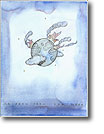Jack S. Blanton Museum of Art,
Jan 30, 2004 - Jul 18, 2004
Austin, TX, USA
Fishing in International Waters
by Annie Laurie Eddleman
Artists:
Cecilia Vicuña, Cesar Paternosto, Cildo Meireles, Abel Barroso, Yoshua Okon, Leon Ferrari, Katie van Sherpenberg, Diego Gravinese, Raul Quintinilla, José A. Toirac, Fernando Rodriguez, Victor Grippo, Jorge Macchi, Julio Alpuy, Esteban Lisa, Carlos Colombino, Oswaldo Salerno, Flavio Garciandia, Tonel (born Antonio Eligio Fernandez), Fernando Rodriguez, Anton Vidokle, Alejandro Cornjeira, Gego (born Gertrud Goldschmidt), Maria Freire, José Pedro Castigliolo and Waltercio Caldas. The spring exhibition of Latin American art at the University of Texas at Austin’s Blanton Museum may not be causing sky to fall nor earth to shake. It is, however, breaking important ground--tacitly, subtly, but determinedly. Fishing in International Waters, as the exhibition is called, is a showcase of 30 of the museum’s recent acquisitions of Latin American art that seeks to approach some of the issues of exhibiting Latin American art in innovative ways. In part following MFAH curator Mari Carmen Ramírez’s theory of the constellation model for exhibition, curator Gabriel Perez Barreiro has grouped the works in the exhibition by how the interrelationships of the works sharing a space play off of one another to emphasize the important discourses of the works’ forms and content. Perez Barreiro wants viewers to understand these works in terms of the information they offer in dialogue, and not in terms of being representative of the art or culture of a nation or region. The Blanton’s downstairs exhibition space is perhaps on the small side, and with the moveable walls there are times when it seems a bit crowded, even when sharing the space with only one or two people. However, an advantage of the tightness of space is a sense of intimacy with the works. In a section of the gallery, the dialogue between artworks is heightened by their proximity and by the viewer’s situation in their midst. The labels in Fishing in International Waters are part of the quiet innovation of this exhibition. Rather than give the artist’s nationality in adjectival form (i.e. Cecilia Vicuña, Chilean), Perez Barreiro has chosen to list the artists’ places of birth, where they lived or live and work, and, if applicable, where they died. This is important for demonstrating that the artists are very mobile, and that there are a number of influences at play. Relegating them to being defined by nationality would limit the viewer’s ability to understand the work.
|


![Internet de Madera [Wooden Internet] by Abel Barroso](images/cu_barro_08_md.jpg)

![Marina metafísica [Metaphysical Marine] by Julio Alpuy](images/uy_alpuy_04_md.jpg)
![Marina metafísica [Metaphysical Marine] by Julio Alpuy](images/ar_gravi_01_im.jpg)


![Internet de Madera [Wooden Internet] by Abel Barroso](images/cu_barro_08_md.jpg)

![Marina metafísica [Metaphysical Marine] by Julio Alpuy](images/uy_alpuy_04_md.jpg)
![Marina metafísica [Metaphysical Marine] by Julio Alpuy](images/ar_gravi_01_im.jpg)